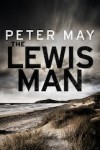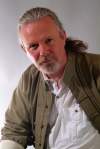In Peter May’s new hardback original THE LEWIS MAN (Quercus, January 2012), an unidentified corpse is recovered from a peat bog and the only clue to its identity is a DNA sibling match to a local farmer. But this islander, Tormod Macdonald, now an elderly man suffering from dementia, has always claimed to be an only child. When Tormod’s family approaches Fin Macleod for help, Fin feels duty-bound to solve the mystery.
THE LEWIS MAN is the follow-up to May’s international bestseller THE BLACKHOUSE, which the IRISH INDEPENDENT described as “a beautifully written, haunting and powerful examination of the darkness of men’s souls … An outstanding page-turning murder mystery.”
May is the author of several standalone novels and two series, including the award-winning China Thrillers, featuring Beijing detective Li Yan and American forensic pathologist Margaret Campbell, and the critically acclaimed Enzo Files, featuring Scottish forensic scientist Enzo MacLeod, which is set in France where May now lives.
One of Scotland’s most prolific television dramatists, he garnered more than 1,000 credits in 15 years as scriptwriter and script editor on prime-time British television drama. He is the creator of three major television drama series and presided over two of the highest rated series in his homeland before quitting television to concentrate on his first love, writing novels.
Would you describe your path to becoming a novelist?
Although I spent years working as a journalist, then a screenwriter and producer, I have always considered myself a novelist—after all, I wrote my first book at the tender age of four. I recently rediscovered the original manuscript in a box in the attic, scanned it, turned it into a short slideshow and put it up on YouTube. So it is now possible to read my very first book here.
I was 25 when I became a published novelist. I was working as a journalist, so not unexpectedly the story was a thriller about an investigative reporter. I then developed that idea for television and sold it to the BBC, which is how I ended up being a scriptwriter.
When I finally gave up television in the mid-nineties to try to make a living as a novelist, I embarked on my first series, which was set in China. I spent nearly eight years traveling back and forth to China, and around that country, to research the six books that I wrote, and became the first Western writer to get full access to the Chinese police.
What are some big differences between journalism and novels?
When I became a full-time novelist, I brought with me two important attributes which I had learned as a journalist. These were the ability to research any subject from a position of zero knowledge to one of near expert in a short period of time, and to write fast. I spend three to four months developing and researching a novel, but when I sit down to write it, I work very quickly, writing 3,000 words a day and finishing it in around seven weeks.
The other important role that journalism played in my creative writing was the experience of life that it provided—from the slums of Glasgow to the hallowed corridors of the House of Commons in London. There are not many people who can say they have met four British Prime Ministers personally.
How is the writing process for television different from for your novels?
In truth, I apply the same writing processes to my books as I did to writing for television—developing scene by scene skeletal outlines, and employing a great deal of dialogue to advance story and develop character.
I think most novelists write pretty bad dialogue—I did myself before honing that ability during 15 years as a screenwriter. Now I realize what an important tool it is for avoiding narrative exposition, and moving plot forward quickly and easily. And it is so much better for a reader to discover a character’s personality through the words they speak than the novelist’s description.
Since your first novel was published, what are some differences (pro and con) that you’ve experienced with the publishing industry?
I think it is much harder now to get published. There are fewer publishers, and the corporate publishing world is motivated only by profit. My own experience with THE BLACKHOUSE is a perfect example. Rejected by every major publishing house in the UK, it was first published in French by my French publisher who loved it and bought world rights. The book has now sold around the world, and is a bestseller in the UK where it has sold more than 100,000 copies in the last four months.
On the other hand, the advent of simple electronic self-publishing—and marketing—has provided many writers with the opportunity to bypass the traditional publishing route (which has failed to put them in print) and reach tens, sometime hundreds, of thousands of readers who would never otherwise have had the chance to read their work.
What compelled you to write THE LEWIS MAN?
Following the success of THE BLACKHOUSE in France, my publisher put me under pressure to turn it into a series. I didn’t want to do that, and in the end we reached a compromise—a trilogy. So THE LEWIS MAN is the second book in that trilogy. It incorporates a story from a shameful period in 20th century Scottish history about which I had always wanted to write. But is also very personal, because the character who holds the key to the mystery is an old man suffering from dementia, and I was able to use the experience of caring for my own father who was also a dementia sufferer.
Research for the book took me back to the Outer Hebrides of Scotland, where I had spent five years during the 90s producing a television drama serial which was filmed entirely on location. But it also took me to locations in Edinburgh where that part of the story set in the past unravels. I spent several frustrating months searching the Internet for illumination on the subject of the “homers” about which I was writing.
“Homers” are children from orphanages who were taken by the Catholic Church and sent to families in the islands of the Outer Hebrides, where many were treated as slaves, and often subject to terrible abuse. City authorities in Scotland were also complicit in this abhorrent practice, which continued into the 1960s. These children arrived off boats at island ports, where they were left standing on the quayside with cards hanging around their necks bearing the surname of the families to whom they’d been allotted.
This was a practice well-hidden from the public at large, and is still mired in obscurity today. But I was lucky enough to track down some “homers” for myself, as well as interviewing the last orphan to leave the Edinburgh orphanage (in the 1950s) which I used in the book.
How much time do you spend writing compared with editing, and do you outline your books?
When I have developed my story and characters, and done the bulk of my research, I write a very detailed synopsis—a scene-by-scene breakdown which is usually around 20,000 words in length. This is where I generate and enjoy the white heat of my creative process. I work very fast and usually complete the synopsis in about six days (it is far easier to make structural changes to a synopsis at this stage than to a large, unwieldy finished manuscript). I then research my locations, and start to write. I get up at six in the morning, and write until I have completed 3,000 words. I stop on the 3,000th word—even if it is in the middle of a sentence. That way I know exactly what I am going to write next when I sit down the following morning, and never have writers block. My editing process is usually a polishing one, rather than a rewriting one.
To learn more about Peter, please visit his website.


